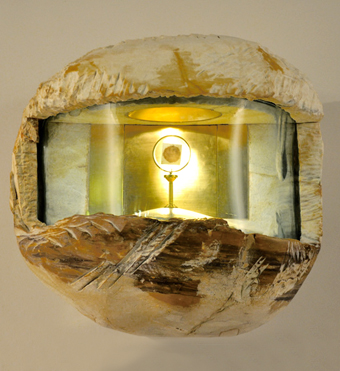|
The Eucharist is the memorial of Christ’s Passover, that is, of the work of salvation accomplished by the life, death and resurrection of Christ.
It is Christ Himself, the eternal high priest of the New Covenant who, acting through the ministry of the priests, offers the Eucharistic sacrifice. Only validly ordained priests can preside at the Eucharist and consecrate the bread and the wine so that they become the Body and Blood of the Lord.
The essential signs of the Eucharist sacrament are wheat bread and grape wine, on which the blessing of the Holy Spirit is invoked and the priest pronounces the words of consecration spoken by Jesus during the Last Supper “This is my Body which will be given up for you....This is the cup of my Blood.....”
By the consecration, the transubstantiation of the bread and wine into the Body and Blood of Christ is brought about. In the consecrated bread and wine, Christ Himself is present in a true, real and substantial manner : His Body and His Blood, with His Soul and His Divinity.
Eucharist Miracle in Cascia in AD 1330
28 April 2019
Jesus said “I am the living bread that came down from heaven; if any one eats of this bread, he will live for ever............he who eats my flesh and drinks my blood has eternal life and.........abides in me, and I in him. (John 6:51,54,56)

In the year AD 1330, a priest in Siena was asked to administer the Holy Eucharist to a dying sick man in his town. He agreed to this request but irreverently placed the Consecrated Host between the pages of his breviary instead of placing it in a Pyx and carrying it close to his heart. When he arrived at the sick man’s house and opened the breviary to give him the Communion, he found that the Host was bleeding and there were round stains of blood on the two pages of the breviary where it was placed.
He immediately repented for what he had done and rushed to the nearby Augustinian monastery in Siena to confess and narrate what had happened to Blessed Fr. Simon Fidati who was a well known holy man. He granted absolution to the truly repentant priest and took the two pages and placed one in a tabernacle in Perugia and the other he bought to the Augustinian monastery of Cascia in Italy and placed it in a reliquary.
The pages were preserved and numerous tests were performed. In 1389, Pope Boniface IX confirmed the authenticity of the miracle.
Over the years, a secondary miracle too has been observed on the paper. The blood stains have formed the outline of a human face. Both pages now show the face of a man with a beard. To this day, the stains of the Precious Blood can be seen on the pages of the breviary which are preserved in the lower chapel of the Basilica of St. Rita in Cascia, Italy. The fragment of parchment paper measures 52 x 44 mm and is kept in a stone and crystal tabernacle, flanked by two marble panels depicting the two sides of an open book.
The relic of the Eucharistic Miracle has been venerated by the faithful for centuries now. Various Popes promoted its veneration with special indulgences, including that of Portiuncula by Pope Boniface IX in 1401. This miraculous event is also commemorated every year on the feast of Corpus Christi, when the relic is carried solemnly in procession.
Why should we receive Holy Communion?
Communion with the Body and Blood of Christ increases the communicant's union with the Lord, forgives his venial sins and preserves him from grave sins. Receiving this sacrament strengthens for each of the communicant, their bond of love with Jesus Christ, and this collectively also results in reinforcing the unity of the Church which is the Mystical Body of Christ.
What are the essentials for receiving Communion?
1. The Communicant should be baptized in the Catholic Church and be a member of any Catholic Church which is in communion with the teachings of the Holy Father and the Magisterium of the Church.
2. The Communicant should be in a state of grace, i.e should have confessed all mortal sins
3. The Communicant should have abstained from food and drink (except water) one hour before receiving Communion. This does not apply to the sick.